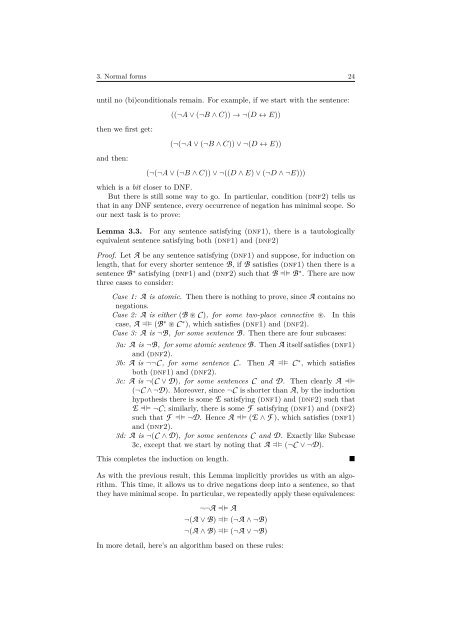Metatheory - University of Cambridge
Metatheory - University of Cambridge
Metatheory - University of Cambridge
Create successful ePaper yourself
Turn your PDF publications into a flip-book with our unique Google optimized e-Paper software.
3. Normal forms 24<br />
until no (bi)conditionals remain. For example, if we start with the sentence:<br />
then we first get:<br />
and then:<br />
((¬A ∨ (¬B ∧ C)) → ¬(D ↔ E))<br />
(¬(¬A ∨ (¬B ∧ C)) ∨ ¬(D ↔ E))<br />
(¬(¬A ∨ (¬B ∧ C)) ∨ ¬((D ∧ E) ∨ (¬D ∧ ¬E)))<br />
which is a bit closer to DNF.<br />
But there is still some way to go. In particular, condition (dnf2) tells us<br />
that in any DNF sentence, every occurrence <strong>of</strong> negation has minimal scope. So<br />
our next task is to prove:<br />
Lemma 3.3. For any sentence satisfying (dnf1), there is a tautologically<br />
equivalent sentence satisfying both (dnf1) and (dnf2)<br />
Pro<strong>of</strong>. Let A be any sentence satisfying (dnf1) and suppose, for induction on<br />
length, that for every shorter sentence B, if B satisfies (dnf1) then there is a<br />
sentence B ∗ satisfying (dnf1) and (dnf2) such that B ⊨ B ∗ . There are now<br />
three cases to consider:<br />
Case 1: A is atomic. Then there is nothing to prove, since A contains no<br />
negations.<br />
Case 2: A is either (B ⊛ C ), for some two-place connective ⊛. In this<br />
case, A ⊨ (B ∗ ⊛ C ∗ ), which satisfies (dnf1) and (dnf2).<br />
Case 3: A is ¬B, for some sentence B. Then there are four subcases:<br />
⊨<br />
3a: A is ¬B, for some atomic sentence B. Then A itself satisfies (dnf1)<br />
and (dnf2).<br />
3b: A is ¬¬C , for some sentence C . Then A ⊨ C ∗ , which satisfies<br />
both (dnf1) and (dnf2).<br />
3c: A is ¬(C ∨ D), for some sentences C and D. Then clearly A ⊨<br />
(¬C ∧ ¬D). Moreover, since ¬C is shorter than A, by the induction<br />
hypothesis there is some E satisfying (dnf1) and (dnf2) such that<br />
E ⊨ ¬C ; similarly, there is some F satisfying (dnf1) and (dnf2)<br />
such that F ⊨ ¬D. Hence A ⊨ (E ∧ F ), which satisfies (dnf1)<br />
and (dnf2).<br />
3d: A is ¬(C ∧ D), for some sentences C and D. Exactly like Subcase<br />
3c, except that we start by noting that A ⊨ (¬C ∨ ¬D).<br />
⊨<br />
This completes the induction on length.<br />
⊨<br />
As with the previous result, this Lemma implicitly provides us with an algorithm.<br />
This time, it allows us to drive negations deep into a sentence, so that<br />
they have minimal scope. In particular, we repeatedly apply these equivalences:<br />
¬¬A<br />
¬(A ∨ B)<br />
¬(A ∧ B)<br />
⊨<br />
⊨<br />
⊨<br />
⊨ A<br />
⊨<br />
⊨ (¬A ∧ ¬B)<br />
⊨ (¬A ∨ ¬B)<br />
In more detail, here’s an algorithm based on these rules:<br />
⊨<br />
⊨<br />
⊨<br />
⊨<br />
■
















